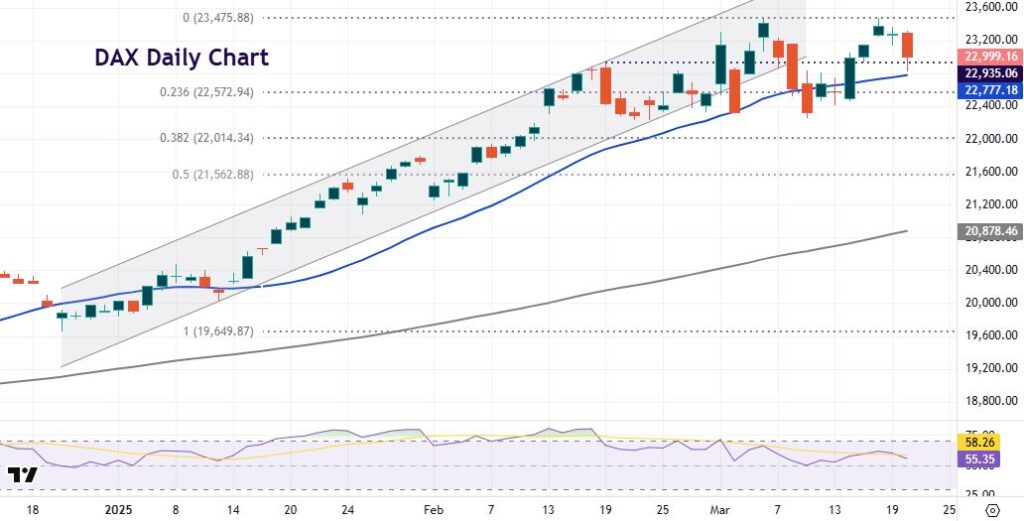Wall Street dips as Fed-driven rally fades, USD perks up

- BoE holds interest rates, signals caution ahead; traders trim rate cut bets
- EU delays first set of retaliatory tariffs in trump trade war
- Dollar firms as markets digest Fed outlook and economic data
- S&P 500 falls as Wall Street struggles from month-long rout
FX: USD moved higher but looked to be struggling to break initial resistance at 103.98. The FOMC meeting hinted at more concern about inflation, but the Fed is in no rush to move policy amid major uncertainty. Money markets reflect around 65bps of rate cuts for this year. The 50-day and 200-day SMAs reside at 104.94 and 104.95. A death cross could be forming as the 50-day could cross below the longer-term indicator. This is seen as bearish. A downside break through 103.20 could see a move to next support at 102.30 relatively quickly, after recent consolidation.
EUR fell for a second straight day as EZ/US interest rate differentials widened while European stocks have underperformed their US counterparts this week. ECB President Lagarde warned that US tariffs and EU retaliation would cut the region’s growth by half a percentage point and raise inflation by about the same amount. But she did say the impact would be temporary, suggesting that rate setters may look through this one-off driver. Prices bounced off support intraday at 1.0817.
GBP finally turned lower after again failing to decisively break above 1.30 over this week. UK wage data remained sticky even though the jobless rate ticked up two-tenths to 4.7%. The BoE meeting was fairly quiet, with the MPC fairly vague about their next steps. Caution around inflation was palpable but markets still see just over two 25bps rate cuts for this year. Initial support in cable comes in at 1.2924, a major retracement Fib level of the September/January drop.
USD/JPY gained modestly as it followed the lead of the 10-year US Treasury yield. Prices remain below the 50-day SMA at 148.90. This comes after Wednesday’s failure to break out of the long-term bear channel.
AUD underperformed sharply, falling for a third day in a row. Disappointing jobs figures showed a shock contraction in roles added (-52.8k vs +30k expected) and a drop in the participation rate. USD/CAD traded below its 50-day SMA at 1.4345. The media is reporting that new PM Carney will call a snap election on April 28th. That’s likely increases the uncertainty factor for the loonie heading into April and Trump’s tariff announcement on the 2nd.
US stocks: The S&P 500 lost 0.22% to settle at 5,662. The tech-heavy Nasdaq finished down 0.3% at 19,677. The Dow slid 0.03% to close at 41,953. The VIX, Wall Street’s fear gauge, dropped below 20 and has now declined seven days in the last eight, after topping out close to 30. The long-term median average is around 17.5. Broadcom led chips lower with a 2% fall, while Accenture tumbled 7.4% after the CEO warned revenue will be hurt by DOGE and the Trump administration’s efforts to slash us government costs.
Asian stocks: Futures are mixed. APAC stocks traded mixed again on the back of the wait-and-see FOMC meeting, which left rates unchanged, as expected. The ASX 200 outperformed with gains led by real estate and tech. Markets shrugged off weaker than forecast jobs data. The Nikkei 225 was closed for Vernal Equinox Day. The Hang Seng and Shanghai Comp were both soft as investors digested earnings releases. There was disappointment over the decision to keep the China one-year and five-year loan rate unchanged for a fifth straight month.
Gold made another fresh record high at $3057 before pulling back and printing a doji candle denoting indecision. Wednesday’s Fed meeting was marginally more hawkish, as reflected in less rate cuts in the 2025 median dot plot than the current market forecast.
Day Ahead –Japan CPI
The BoJ and Governor Ueda emphasised their commitment to policy normalisation at the meeting earlier this week. Though there was no indication of when the next rate hike will be, today’s CPI inflation data will help steer that decision. It is expected to ease to 3.5% y/y in February from 4.0% in January. This drop was due to renewed government energy subsidies and a stabilisation in fresh food prices.
Perhaps more important than these figures will be the April Tokyo CPI data which will be released a few days before the BoJ’s April/May meeting. If April Tokyo inflation reaccelerates as many economists predict, then odds of a May rate hike will likely increase. That should help the yen which remains a solid uptrend versus the dollar. (ie USD/JPY is in a downward channel)
Chart of the Day – Soaring Dax takes a breather
The German Dax stock market index has outshone virtually everyone’s expectations in the first few months of the year. As US exceptionalism has faded, so investors have hoovered up cheaper assets elsewhere. The game-changing release of the German debt handbrake has further enhanced the attractiveness of the Dax, while the potential Ukraine ceasefire has also buoyed eurozone assets. We note that 10 stocks make up over 50% of the Dax index.
Prices have rocketed higher since bottoming out just above 17,000 at the start of August. The upward trend picked up in pace in 2025 but looks to have topped out around 23,475. Market found failed here a couple of times which reinforces that barrier. Initial support is 22,935, and then 22,572. The major Fib retracement level (61.8%) of the December/March rally is 22,014.

